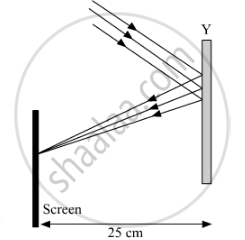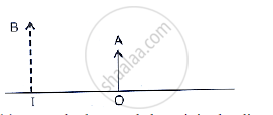Advertisements
Advertisements
Question
Write the three characteristics of the image formed by a convex lens of focal length 20 cm for the object at distance (i) 10 cm, (ii) 30 cm, (iii) 40 cm, (iv) 60 cm from the lens.
Solution
(i) For the object at distance 10 cm, the image is virtual, upright, and enlarged.
(ii) For the object at distance 30 cm, the image is real, inverted, and enlarged.
(iii) For the object at distance 40 cm, the image is real, inverted, and the same size.
(iv) For the object at distance 60 cm, the image is real, inverted, and diminished.
APPEARS IN
RELATED QUESTIONS
One-half of a convex lens is covered with a black paper. Will this lens produce a complete image of the object? Verify your answer experimentally. Explain your observations.
A student places a candle flame at a distance of about 60 cm from a convex lens of focal length 10 cm and focuses the image of the flame on a screen. After that he gradually moves the flame towards the lens and each time focuses the image on the screen.
(a) In which direction-toward or away from the lens, does he move the screen to focus the image?
(b) How does the size of the image change?
(c) How does the intensity of the image change as the flame moves towards the lens?
(d) Approximately for what distance between the flame and the lens, the image formed on the screen is inverted and of the same size?
Study the given ray diagrams and select the correct statement from the following:


(A) Device X is a concave mirror and device Y is a convex lens, whose focal lengths are 20 cm and 25 cm respectively.
(B) Device X is a convex lens and device Y is a concave mirror, whose focal lengths are 10 cm and 25 cm respectively.
(C) Device X is a concave lens and device Y is a convex mirror, whose focal lengths are 20 cm and 25 cm respectively.
(D) Device X is a convex lens and device Y is a concave mirror, whose focal lengths are 20 cm and 25 cm respectively.
Where should an object be placed in order to use a convex lens as a magnifying glass?
How could you find the focal length of a convex lens rapidly but approximately?
An object 2 cm tall is placed on the axis of a convex lens of focal length 5 cm at a distance of 10 m from the optical centre of the lens. Find the nature, position and size of the image formed. Which case of image formation by convex lenses is illustrated by this example?
The given below figure shows an object OA and its image IB formed by a lens.

If you are to determine to focal length of a convex lens, you should have
(A) a convex lens and a screen
(B) a convex lens and a lens holder
(C) a lens holder, a screen holder and a scale
(D) a convex lens, a screen, holder for them and a scale
Can a normal convex lens behave like a concave lens and vice-versa?
How will you determine the focal length of a convex lens by the plane mirror method?
